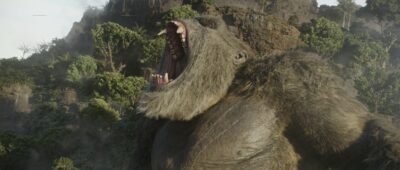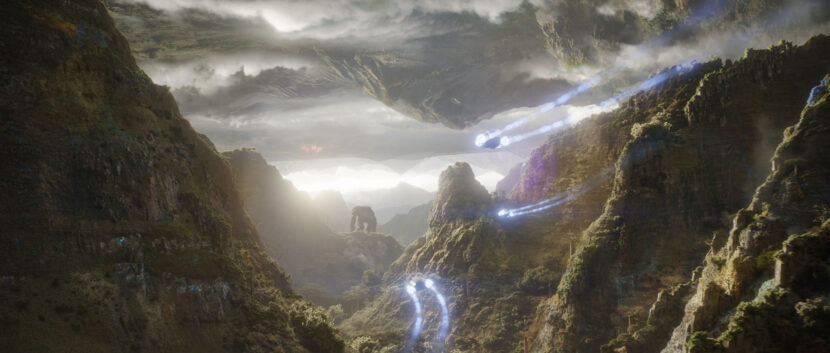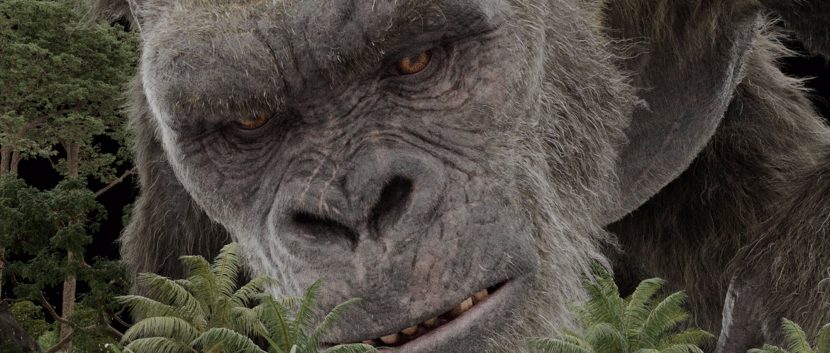Godzilla vs. Kong
Godzilla vs. Kong is a classic hero’s journey that follows Kong on his quest to reconcile his past and defend his future. Weta Digital worked hand-in-hand with filmmakers to imagine and visualize shots of Kong’s story moments and the film’s epic landscapes. Weta’s work span across Skull Island, Antarctica, and most interestingly the new world of Hollow Earth with weird gravity. Weta Digital will also be presenting its work at this year’s FMX conference (see the bottom of this story).
Their work encompassed
- Animating Kong—animation beats, editing style, and pacing were heavily explored from the early stages of production.
- Thirteen hero environments, some of which sprawled hundreds of kilometers. One particular note is the inverted landscape of Hollow Earth, and the setting for the military hanger in Antarctica, where wild weather whips through the scenes, coating sets, and Kong in layers of snow.
- Spectacular FX created to travel to Hollow Earth, via the inversion vortex
- The various fearful creatures that populate Hollow Earth such as the Lizards, Yoshuma, and the Nozuki.
Size of Kong
Weta Digital supervisor was Kevin Smith, and fxguide sat down with Kevin to discuss Kong and in particular the complexity of building characters that are so vast, so enormous, and yet need to both interact with a normal world of trees and snow, -as well as float in near zero-gravity, all while exhibiting believable fur simulations!
Weta Digital has unparalleled experience in monkeys, primates, and expressive apes. Kong is the largest ape or primate that Weta Digital has yet done, but not the first that has been in zero gravity: see (Ad Astra and Space Force ). Kong in this film is 100 m (300ft) tall, which is actually significantly taller than he was in his last film. This was to match him better with Godzilla. In Kong: Skull Island, Kong was about half this height (50m), “they made him even bigger here so that you have two monsters, the same size, fighting each other,” explains Smith. What was nice for Weta and the animators is that Kong is not just a roaring monster, Kong has a character arc and provides complex emotions during the film, requiring skilled facial and character animation. All of that animation, supervised by Weta’s Dave Clayton, was key-framed and not motion captured as has been reported.
The size issue is one of many that the Weta animators needed to skillfully solve. In an action film, the audience expects a certain pace and that does not always gel with reality. This means the animators have to provide a form of visual logic that seems plausible, exciting and natural, while not being based on any actual real-world physics. “In one of our first motion tests, we did a test shot where we pulled the camera back on Kong to reveal him running across a flat plane. We were just trying to figure out how he was going to move when he’s running,” recalls Smith. “We had one animation where we were all in agreement – ‘Oh, that’s really cool.” And then someone lent over and said,” um, yeah, it looks really nice, but Kong’s going 600 kilometers now!” In some film’s there is an absolute ground truth, and animators and TDs are required to make something that matches it. In Godzilla vs. Kong, the task is actually much harder. The animators have to not only animate the giant Kong at unrealistic speed – and still look right to the audience, but he is also constantly interacting with the world, and gravity is a constant, so for a giant tree to not fall like a toothpick visually, it needs to take several seconds to fall through frame. But Kong’s feet need to move faster than that, yet Kong cannot have a different gravity than the things he touches or smashes. “The simulation forces become ridiculous, and the speed of everything is ridiculous,” says Smith. “We had to have the effects simulation team come up with some trickery to make sure that things would break in a believable way, and then fall at the right speed. Once debris is falling in a ballistic arc, in a live-action plate, it has to fall with real-world gravity. The second you have a different gravity for different things, the audience would notice.”
Kevin Smith, who joined Weta Digital for Academy Award-winning The Lord of the Rings: The Fellowship of the Ring (2001), has never worked directly on Weta’s award-winning Planet of the Apes films. He has worked on and contributed to the look development of Gollum, as well as working on films such Avatar and Mortal Engines at Weta, but this was his first ape film. ”
Clayton and Smith decided early on to block and light Kong as a ‘movie star’ actor. “Dave and I talked about this from the very beginning, about how to get the camera up on him and lighting him like an actor, – treating him as an actor and just letting him act out his emotional arc,” Smith explains. The issue with raising the camera up 100 m is that the sense of scale is naturally diminished. Added to this, any character that is this big would move very slowly on screen – just as a function of scale.
The facial animation was particularly key as Kong has no dialogue and yet the audience needs to have an emotional connection with him as he goes on his ‘hero’s journey’ that leads to the very center of the earth. A Hollow Earth that posed two huge challenges, how Kong would ‘float’ in a near zero-G environment and where the heck is the light coming from?
Hollow Earth
When Kong descends to the center of the earth, there is an incredible scene where be floats from one ground up to another. This was such a complex sequence that Smith actually drew a map and plotted out which up or down Kong was on at any time.
The scale of hallow earth was helped by depth cues from a form of atmospheric haze, but the issue of light sources was more difficult to solve. While almost every audience member would just accept Weta’s lighting design, Smith himself was faced with the issue of how to instruct the lighting team where to position the light source and the nature of quality of that light. The solution was to imply that the volcanos were providing the light, at least initially. As the scenes looked exterior and so the issue was to hint at a solution and then just provide plausible magic hour lighting and due to the engaging nature of the story, no one questions it. “From the very beginning we were asking ourselves, ‘how do we do this?’, ” Smith recalls. The initial idea from the client was to have lots of volcanoes everywhere. and if there were enough volcanoes glowing the audience would just buy that Hallow earth was lit up, “Even though it would never work. In reality, it would just be these little pools of light around the tops of volcanoes and everything else would be pitch black,” he adds. This logic morphed into just having the one volcano at the temple, which the audience can see in that shot, where Kong first falls. “We made it bright enough to kind of cheat it as a sun. And after that, we just said, ‘well, if there’s one, there’s gotta be more, and ‘hey, that’s where the light comes from’,” he laughingly recalls. The impressive thing is how well the Weta Look Dev and Lighting team do make this work in the film and it does look believable to an audience. Technically, it did mean creating a special spherical HDR with earth at the bottom and the top of the projection and a band of sky only at the middle. Which made it one of the more unusual HDRs the Weta lighting team has ever had to use.
Hollow Earth also proved an interesting challenge for more than just the sims team or lighting department. While in Hollow Earth Kong goes to the ancestral home at the throne room. The challenge for the modeling department was to produce a structure on a giant scale, but now have the audience question who made it or how. Internally at Weta, it was decided that thematically the throne room had been built by something like prehistoric people with primitive tools, but at Kong scale, and furthermore, the ‘people’ in this case were monkeys. The team nicknamed this ‘Monkey tech’. Smith hints that there may have been more backstory in an earlier script, but again it is credit to the team that the stadium-sized throne room, with Godzilla ‘energy’ tech, seems completely reasonable when one is watching the film. It feels all a natural extension of Kong’s culture and very much like Kong has found his way home. One can nitpick details of backstory, but audiences loved the film, and the Weta crew solved very complex and difficult visual problems time and time again in ways that seem natural and visually plausible but that must have seemed nearly impossible at some point.
Fur
Both in Hollow Earth and back on the surface, Kong’s fur was a challenge. In Hollow Earth, the fur should have floated up, as Kong moved from one gravity (lower) to another (upper), but again such realism would have made Kong puff up like a furball and so the effects team artfully managed his fur to fall down as part of the groom, and thus was always correctly orientated to the body direction of Kong.
Kong’s fur size was also an issue, given his vast height at 100m, his fur hair strands would each be the thickness of a small tree branch as seen in these images below.
The technical scale problems of selling Kong’s fur only becomes more complex in the scenes where Kong is in the snow. Weta Digital had done Caesar in snow in one of the Apes films, but at human scale, the team could use snowflakes falling on Caesar’s fur to produce stunningly realistic imagery. In this film scale removed this as an option. Actual snowflakes would never be seen next to the 100m Kong. Smith and the team’s solution were to groom Kong in a similar way to Caesar but to make Kong have large piles of snow on him in a way that resembled snowflakes but were actually large clumps or piles of snow.
Smith recalls one funny incident that happened during this stage of production. As with all such projects the art department sends reference imagery to the effects team for the sort of thing they are after. Smith recounts that “we started talking about Antarctica and Adam (Wingard, the director) said he would actually send us reference of a monkey with snow on it that they really liked. And the funniest thing about that was they sent us a clip from Planet of the Apes,” he joked, ”And we responded,’…Okay. Yeah. We can do that!’” The production team had sent Weta a clip of Caesar after he’d been rolling around in the snow, that Weta had made a few years before.
In the end, all visual effects problems are not solved to make something look real, they are often about telling the story and making the imagery seem natural for that point in the story. The artistry of visual effects is making the impossible plausible and entertaining. The global reaction to Godzilla vs. Kong demonstrates that all the teams producing imagery for this film succeeded in doing this and in so doing restored faith in people’s desire to go to the movies and enjoy a well-told giant tale.
FMX 2021
Weta Digital will be presenting at FMX (Thurs 6th: Sydney 5pm Stuttgart, Germany 9am). In this talk, CG Supervisor Stephen Tong teams up with Animation Lead Edwina Ting to discuss Kong and the evolution of his personality and creating some of the amazing worlds he explores.
Edwina Ting, Senior Animator at Weta Digital. Edwina Ting has animated at Weta Digital for over a decade. She was senior animator on Godzilla vs. Kong. She was also recently a senior animator on Alita: Battle Angel, contributing to the highly creative keyframed motorball chase sequence.
Stephen Tong, CG Supervisor at Weta Digital. Stephen Tong brings a wealth of experience and passion for creature work to his role as CG Supervisor. He was also recently involved in the unique challenge of bringing Weta Digital’s original visual effects created for Zack Snyder’s 2017 version of Justice League backinto the pipeline for the new 2021 version of the film.
PLUS ALSO AT FMX 2021

Also check out Mike’s chat with the 2021 Oscar winners Andrew Jackson and Scott Fisher : The TENET Effect: Unpacking the Collaboration of Special and Visual Effects (now online) and the digital human track with Pinscreen’s Hao Li, DI4D’s Colin Urguhart and Respeecher’s Alex Serdiuk. : Giving Digital Humans a Voice. The digital human group discusses the validity of hybrid models of CG and AI and the future of enhancing traditional workflows with machine learning approaches.















